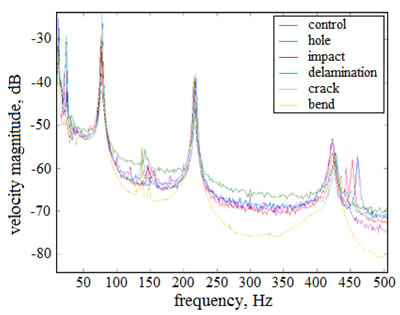Several research groups have contributed to SHM related work on composite structures using different methods for effective evaluation of damages to the structures and their well being. Kessler et al [2002], in their review paper on ‘Structural health monitoring in composite materials using frequency response methods’ have presented part of an experimental and analytical survey of candidate methods for the detection of damage in composite materials. The experimental results are presented for the application of modal analysis techniques applied to rectangular laminated graphite / epoxy specimens containing representative damage modes, including delamination, transverse ply cracks and through-holes (Figure 10.3). Changes in natural frequencies and modes are found using a Scanning Laser Vibrometer and 2-D finite element models are created for comparison with the experimental results.

Figure 10.3 : Frequency response plot using Laser Doppler Vibrometer for damaged specimens
The models have accurately predicted the response of the specimens at low frequencies, but the local excitation and coalescence of higher frequency modes make mode-dependant damage detection difficult and most likely impractical for structural applications. The frequency response method is found to be reliable for detecting even small amounts of damage in a simple composite structure, however, the potentially important information about damage type, size, location and orientation are lost using this method since several combinations of these variables can yield identical response signature.
|